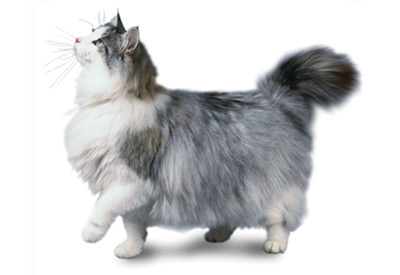Type the name of the breed you're looking for below
[wpdreams_ajaxsearchlite] Don't see the breed your're looking for? Click here and let us know!
Breed Characteristics
1 paw - breed exhibits the least amount of this characteristic
5 paws - breed exhibits most amount of this characteristic
Norwegian Forest Cat
| Origin And History | The Norwegian Forest Cat, called the skogkatt (forest cat) in Norway, is a natural breed and despite its feral appearance is not a descendant or a hybrid of any wild cat species. Forest Cats probably arrived in Norway from Europe, descendants of domestic cats introduced to northern Europe by the Romans. It is supposed that the Norwegian Forest Cat has existed for a long time, since several mentions of large, long haired cats exist in Norse mythology. Estimates of when these cat tales were written vary greatly. Most Norse myths were passed down by oral tradition and were finally recorded in what was called the Edda poems, written sometime between 800 A.D. and 1200 A.D. These myths suggest that domestic cats have been in Norway for hundreds, possibly thousands, of years. Whether the cats portrayed in the myths are Forest Cats is subject to debate. When cats arrived in the northern countries, most likely with human settlers, traders, or crusaders, the breed's progenitors were probably short haired, since the cats transported by the Romans came from Egypt (generally) and were short haired varieties. The cats survived and in time adapted to the severe climate. Northern Norway, where the sun never sets from May 12 to August 1, and where the winter nights are correspondingly long and dark, proved a harsh test for these cats. Over the centuries of prowling the Norwegian forests, they developed long, dense, water-resistant coats, hardy constitutions, quick wits, and well-honed survival instincts. The first efforts to have the Forest Cat recognized as a distinct breed began in the 1930s. The first Norwegian cat club was founded in 1934, and in 1938 the first Forest Cat was exhibited at a show in Oslo, Norway. World War II, however, put a damper on all cat breeding and showing, and after the war the breed came close to extinction. Interbreeding with Norway's short haired domestic cat (called the hauskatt) threatened the Forest Cat's existence as a pure breed. It wasn't until the 1970s that the cat fanciers of Norway started a serious breeding program to preserve the Norwegian Forest Cat. |
| Personality | Natural athletes, Norwegian Forest Cats love to investigate counters, bookcases, and the loftiest peaks of their cat trees. "Wegies" are active and playful and retain their fun-loving spirit well into adulthood, but don't be fooled by the breed's impressive muscles and all-weather exterior. They are sweet, friendly, and family-oriented, and they love their human companions. Despite the wild years in the forests of Norway, or perhaps because of it, they would much rather cuddle than prowl. Because of those harsh survival years (perhaps), nothing fazes them much, either. They take new people and new situations in stride; as cats go, Forest Cats are the strong, silent types. They are conversely great purrers, particularly when perched beside their favorite humans. Out-going and gregarious, they tend not to bond with one person, but rather love everyone unconditionally and enthusiastically. |
Physical Attributes
| Appearance | The Norwegian Forest cat is strongly built and larger than an average domestic breed cat. The breed has a long, sturdy body, long legs and a bushy tail. The coat consists of a long, glossy, thick and water-repellent top layer and a woolly undercoat and is thickest at the legs, chest and head. The profile of the breed is generally straight. The head is long, with an overall shape similar to an equilateral triangle, a strong chin, and a muzzle of medium length; a square or round-shaped head is considered to be a defect. The eyes are almond shaped and oblique, and may be of any colour. The ears are large, wide at the base, high set, have a tufted top, are placed in the extension of the triangle formed by the head, and end with a tuft of hair like the ears of the lynx. All coat colours are accepted except chocolate and lilac and the dilutions fawn and cinnamon. Since the cats have very strong claws, they are very good climbers, and can even climb rocks. |
| Health | The cats usually live to be 14 to 16 years old. There have been kidney and heart diseases reported in the breed.[22] In an experiment directed by John C. Fyfea, Rebeccah L. Kurzhals, and others, it was concluded that a complex rearrangement in the breed's Glycogen branching enzyme (GBE1) can cause both a perinatal hypoglycemic collapse and a late-juvenile-onset neuromuscular degeneration in glycogen storage disease type IV in the breed. This disorder, while rare, can prove fatal to cats that have it. There are DNA tests available for GSD IV, and it is highly recommended (some cat associations obligate their Norwegian Forest cat breeder members) to carry out the DNA test before using such animal for breeding. PawPeds provide a pedigree database which comes together with health programmes, through publishing each single cat's test result, to provide useful information for breeders to make a well-informed breeding decision. The breed has also been known to suffer from hip dysplasia, which is a rare, partially hereditary disease of the hip joint. |



